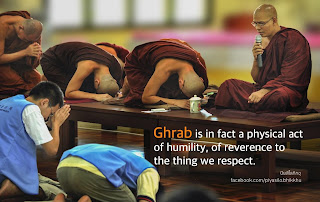Dhamma explanation by Venerable Somdet Phra Buddhaghosacariya (Bhikkhu P.A. Payutto)
It has come to my attention that a couple of German TV show hosts have mocked the Thai custom of showing obeisance by prostrating and bowing, the so-called ‘mhob ghrab’ (mhob = prostrating; ghrab = placing both palms on the floor while bowing), and apparently ridiculed the recent Coronation ceremony in Thailand. Most Thais who saw this will have been upset, so I don’t think I should pass on the link any further. In the wake of this incident, however, many people may ask: "what is the Buddhist response to this?"
Following the Dhamma explanation by Venerable Somdet Phra Buddhaghosacariya (Bhikkhu P.A. Payutto), I think there are two aspects to the Buddhist approach to outside events like this: one is internal, the other external.
The first approach is to keep a calm sense of balance. We need to maintain a wholesome attitude of the heart and not tarnish our virtue. We should forgive those who act from ignorance, for we are all subject to the laws of kamma.
The second approach is to take measures to correct misunderstandings or prevent further damage from taking place.
We can voice how we feel about such actions, point out our different cultural background and do what we can to encourage understanding and help others see things from a different perspective. We should point out the cultural insensitivity of these actions, but all with a sense of generosity and with a mind free from ill will.
As a Buddhist monk, I have long had a deep appreciation for the act of bowing, never perceiving it as a kind of submission to the powers-that-be or an act of subjugating oneself to higher authorities. A deeper reflection on the subject can reveal that the objects of our respect -whether inanimate or living, whether a Buddha image or revered teacher - hardly gain anything from our bowing to them, except, perhaps in the latter case, happiness in seeing virtue in their students. The one who stands to gain most from our prostration is indeed ourselves. In bowing down to what we truly respect, our hearts are filled with joy and our mind is focused on something wholesome, which in turn brings more wholesomeness. We bring to mind the virtues of the paragon we want to take after. In the case of bowing to the Buddha image, we pay respect to the symbol of a liberated being; one who is free of all defilements and represents the ideal goal in our lives. Such an obeisance is indeed a reminder of the ultimate purpose in this life, our resolution to better ourselves towards liberation. In doing so, we realize our shared human capacity to free ourselves from sufferings. All in all, it is ourselves who will gain the most from the act of paying respect.
A common misunderstanding in the West is that when we bow or prostrate ourselves, we are worshipping an external entity. It is not seen as a tool for developing inner virtue. The abstract meaning of 'ghrab' is therefore overlooked and it is viewed, negatively, as an attitude of submission. Ghrab is in fact a physical act of humility, of reverence to the thing we respect.
The greater the respect, the lower the bow. It is an instrument for containing our pride, lowering our attachment to a sense of self and opening our hearts to virtue.
Bowing is part of Thailand's cultural tradition and heritage. Even the King bows down to the Buddha image in the temple, to monks and to people he reveres, such as the Queen Mother and senior members of royalty. He is not above and beyond exception in this act of paying respect. On the other hand, given the iconic status of the monarch, we bow down earnestly in reverence.
Prostration in the royal presence is therefore a traditional gesture of good will, not an act of submission.
Ridiculing and making fun of it are displays of both cultural insensitivity and ignorance. It is best for us to take this as an opportunity to help outsiders understand the inherent raison d'être of bowing.
Venerable Somdet Phra Buddhaghosacariya
Note: This translation of my article in Thai was mainly done by Nopamat Veohong with contributions from many friends. I would like to thank all of them for their kindness and generosity. If there are any mistakes, however, it is still the responsibility of the writer.
https://www.papayutto.org/en/web_page/biography
Growing in Merits
Photo credit : Creative Commons image from pixabay (by truthseeker08

No comments:
Post a Comment